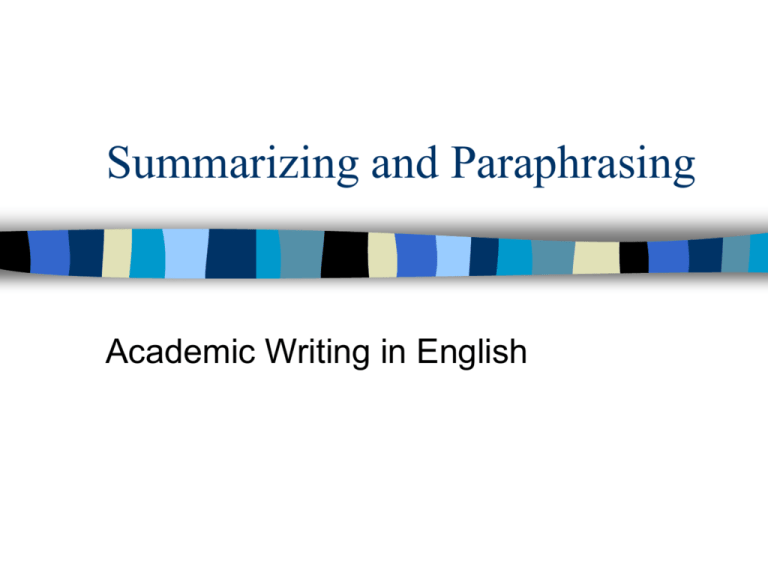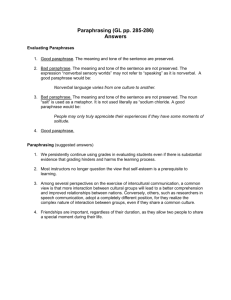the_difference_between_summarizing_and_paraphrasing
advertisement

Summarizing and Paraphrasing Academic Writing in English WHAT IS THE DIFFERENCE BETWEEN SUMMARIZING AND PARAPHRASING? • A summary generalizes the original text in your own words, omitting all unnecessary information. • ’it aims to reduce information to a suitable length’ (Bailey, 2011, p. 50) • • A paraphrase is an explanation of a part of a text in your own words. • It usually focuses on a more specific part of the text than the whole text in general. • ’[it] attempts to restate the relevant information’ (Bailey, 2011, p. 50) • You can paraphrase in a summary. Summarizing Summarizing – macro steps • Decide what are the main ideas and what is subsidiary. • If there are related ideas, try to combine them into a statement of the whole. • Do not add your own comments. • Follow the same order of thoughts and facts. • Edit further. Practice HYPNOSIS TEXT Read the text and in small groups, summarize the text in about 100 words. Answer There are various ways of hypnotising people. In the commonest,the patients are told that hypnosis will help them, is safe, and is not a sign of weakness of character. They are then asked to concentrate on a bright object, and the hypnotist suggests they are going to sleep. The patients goes into a trance, and can be made to remember things they have forgotten, or to do various surprising things. Hypnosis is sometimes used for public entertainment, but this is undesirable. People cannot be hypnotised into doing things they think are wrong. http://www.uefap.com/writing/writfram.htm Example – original text • Pradip, S., and R. Rahim. (1997) There has been much talk of the ”Bombay Miracle” (e.g., Time, August 3, 1996) but rather less of the communication failures of the computer engineers and scienteists in the city. We have developed training courses for engineering graduates stressing cross-cultural differences in negotiation, writing styles, patent laws, and contractual obligations among Indian, Japanese, and North American leaders in technological change. Although no empirical evidence is yet available, there are signs that the case approach to success and failure in Indian computer engineering initiatives for export is having beneficial results. Taken from: English in Today’s Research World, Swales and Feak (2002) U of Michigan Press. Paraphrasing Possible paraphrases 1/4 1. Another communication program is developed by Pradip and Rahim (1997) for engineering graduates. All of these programs show appreciable results. Possible paraphrases 2/4 • Pradip and Rahim (1997) have developed training courses for engineering graduates stressing crosscultural differences via a case study approach of success and failure in Indian computer engineering initiatives for export, and again find signs of beneficial results. Possible paraphrases 3/4 • In their article Pradip and Rahim (1997) talk about the successes in Indian computer engineering and also point out its weakness as a result of communication failures. They relate this with cross-cultural differences and have developed a program for training graduate students stressing cross-cultural differences in negotiations, writing, laws and contracutal obligatuions among Indian, Japanese, and North American leaders in technology. Possible paraphrases 4/4 • Pradip and Rahim have designed training courses stressing cross-cultural differences in engineering communications. Why paraphrase? • it is better than quoting information from an undistinguished passage. • it helps you control the temptation to quote too much. • the mental process required for successful paraphrasing helps you to grasp the full meaning of the original. Source: http://owl.english.purdue.edu/owl/resource/619/01/ [accessed: 2.10.2008] How to paraphrase 1. Reread understand 2. Paraphrase (on a note card).** 3. Jot down a few words below your paraphrase to remind you later how you envision using this material. 4. At the top of the note card - key word or phrase to indicate subject 5. Check your version with the original check accuracy and essential info. 6. Use quotation marks to identify any “unique term” or “phraseology” 7. Record the source (including the page) on your note card. **Paraphrasing on a note card is like making notes because you might go back to that source later. Source: http://owl.english.purdue.edu/owl/resource/619/01/ [accessed: 2.10.2008] More advice (Bailey) • Use synonyms • Arguesclaims, 18th century1700s • Change the word class • Expansion (n) expand (v) • Change the word order • BEWARE OF PATCHWORK WRITING Taken from: Bailey, s., 2011. Academic Writing : A Handbook for International Students. 3rd ed., Oxon: Routledge Practice • http://www.uefap.com/writing/writfram.ht m • ’exercisesreport’ Homework • Textbook reading • Chapters 1.6 – 1.8 Paraphrasing, Summarizing and Referencing • Chapter 2.10 – Academic Style • Chapter 3.2 – Academic Vocabular Extra resources • AWE website: sana.tkk.fi/awe • UEFAP website: http://www.uefap.com/index.htm • OWL Purdue: http://owl.english.purdue.edu/owl/resour ce/563/01/





